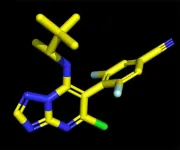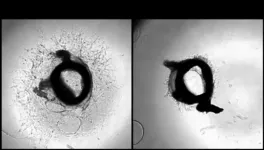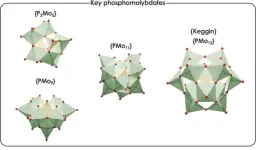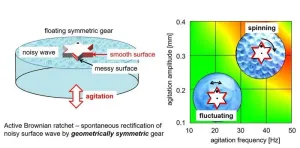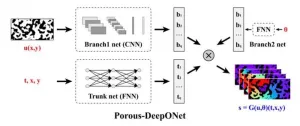(Press-News.org) We know that the Earth has an iron core surrounded by a mantle of silicate bedrock and water (oceans) on its surface. Science has used this simple planet model until today for investigating exoplanets – planets that orbit another star outside our solar system. “It is only in recent years that we have begun to realise that planets are more complex than we had thought,” says Caroline Dorn, Professor for Exoplanets at ETH Zurich.
Most of the exoplanets known today are located close to their star. This means they primarily comprise hot worlds of oceans of molten magma that have not yet cooled to form a solid mantle of silicate bedrock like the Earth. Water dissolves very well in these magma oceans – unlike, for instance, carbon dioxide, which quickly outgasses and rises into the atmosphere.
The iron core is located beneath the molten mantle of silicates. So how is the water distributed between the silicates and the iron? This is precisely what Dorn has investigated in collaboration with Haiyang Luo and Jie Deng from Princeton University with the help of model calculations based on fundamental laws of physics. The researchers present their results in the journal Nature Astronomy.
Magma soup with water and iron
To explain the results, Dorn has to go into some detail: “The iron core takes time to develop. A large share of the iron is initially contained in the hot magma soup in the form of droplets.” The water sequestered in this soup combines with these iron droplets and sinks with them to the core. “The iron droplets behave like a lift that is conveyed downwards by the water,” explains Dorn.
Until now this behaviour had only been known to be the case for moderate pressures of the sort that also prevail in the Earth. It was not known what happens in the case of larger planets with higher pressure interior conditions. “This is one of the key results of our study,” says Dorn. “The larger the planet and the greater its mass, the more the water tends to go with the iron droplets and become integrated in the core. Under certain circumstances, iron can absorb up to 70 times more water than silicates. However, owing to the enormous pressure at the core, the water no longer takes the form of H2O molecules but is present in hydrogen and oxygen.
Large amounts of water are also inside the Earth
This study was triggered by investigations of the Earth’s water content, which yielded a surprising result four years ago: the oceans on the Earth’s surface only contain a small fraction of our planet’s overall water. The content of more than 80 of the Earth’s oceans could be hidden in its interior. This is shown by simulations calculating how water behaves under conditions of the kind that prevailed when the Earth was young. Experiments and seismological measurements are accordingly compatible.
The new findings concerning the distribution of water in planets have dramatic consequences for the interpretation of astronomical observation data. Using their telescopes in space and on the Earth, astronomers can under certain conditions measure the weight and size of an exoplanet. They use these calculations to draw up mass-radius diagrams that permit conclusions to be drawn about the planet’s composition. If in doing so – as has been the case so far – the solubility and distribution of water are ignored, the volume of water can be dramatically underestimated by up to ten times. “Planets are much more water-abundant than previously assumed,” says Dorn.
Understanding evolution history
Water distribution is also important if we wish to understand how planets form and develop. The water that has sunk to the core remains trapped there forever. However, the water dissolved in the magma ocean of the mantle can degas and rise to the surface during mantle cooling. “So if we find water in a planet’s atmosphere, there is probably a great deal more in its interior,” explains Dorn.
This is what the James Webb Space Telescope, which for two years has been sending data from space to Earth, is seeking to find. It is capable of tracking down molecules in the atmosphere of exoplanets. “Only the composition of the upper atmosphere of exoplanets can be measured directly,” explains the scientist. “Our group wishes to make the connection from the atmosphere to the inner depths of celestial bodies.”
The new data of the exoplanet called TOI-270d are particularly interesting. “Evidence has been collected there of the actual existence of such interactions between the magma ocean in its interior and the atmosphere,” says Dorn, who was involved in the corresponding publication about TOI-270d. Her list of interesting objects that she wishes to examine more closely also includes the planet K2-18b, which hit the headlines because of the probability of there being life on it.
Are water worlds life-sustaining after all?
Water is one of the preconditions for life to develop. There has long been speculation about the potential habitability of water-abundant Super-Earths – that is, planets with a mass multiple times greater than the Earth and with a surface covered by a deep, global ocean. Then calculations suggested that too much water could be hostile to life. The argument was that in these water worlds a layer of exotic high-pressure ice would prevent the exchange of vital substances at the interface between the ocean and the planet’s mantle.
The new study now reaches a different conclusion: planets with deep water layers are likely to be a rare occurrence as most of the water on Super-Earths is not located on the surface, as has been assumed until now, but is trapped within the core. This leads the scientists to assume that even planets with a relatively high water content could have the potential to develop Earth-like habitable conditions. As Dorn and her colleagues conclude, their study thus casts a new light on the potential existence of water-abundant worlds that could support life.
END
Planets contain more water than thought
2024-08-20
ELSE PRESS RELEASES FROM THIS DATE:
Blood platelet score detects previously unmeasured risk of heart attack and stroke
2024-08-20
Platelets are circulating cell fragments known to clump up and form blood clots that stop bleeding in injured vessels. Cardiologists have long known that platelets can become “hyperreactive” to cause abnormal clotting that blocks arteries and contributes to heart attack, stroke, and poor blood flow (peripheral artery disease) in the legs of millions of Americans.
Despite this major contribution to cardiovascular risk, routine measurement of whether each patient’s platelets clump (aggregate) too much has been infeasible to date. ...
New international Pioneer Centre for medical data research
2024-08-20
Can research on diseases as diverse as, for example, diabetes, cardiovascular diseases, psychiatric disorders and endometriosis be linked? The answer is yes if the research focuses on collecting and analysing large amounts of data from both Danish and international registers and biobanks to learn more about, among other things, risk factors, relationships, patterns, treatment and consequences.
And this is exactly what a new international Pioneer Centre, The Pioneer Centre for SMARTbiomed (Statistical and Computational Methods for Advanced Research ...
NIH awards $6.9 million to advance potential Alzheimer’s disease treatment
2024-08-20
A multidisciplinary team of scientists led by Carlo Ballatore, Ph.D., at University of California San Diego and Kurt Brunden, Ph.D., at the University of Pennsylvania has been awarded a $6.9 million grant from the National Institute on Aging (NIA) to prepare a potential disease-modifying Alzheimer’s treatment for future clinical trials. In a recently published study about the new compound, called CNDR-51997, the team found it was effective in restoring brain health in mouse models of Alzheimer's disease. CNDR-51997 was identified through a joint drug discovery program at Penn and UC San Diego that was supported by grants from the NIA.
The ...
iSN04: A novel nucleic acid drug for the treatment of vascular diseases
2024-08-20
Atherosclerosis, a major cause of mortality worldwide, involves an overgrowth of vascular smooth muscle cells in the blood vessels, constraining blood flow and potentially causing cardiovascular diseases. Against this backdrop, researchers from Shinshu University recently developed a DNA aptamer called iSN04 that targets and counteracts with the protein nucleolin in smooth muscle cells. This anti-nucleolin aptamer helps maintain smooth muscle cells in a differentiated state, offering new treatment potential for atherosclerosis and other vascular ...
New computational methodology to predict the complex formation of interesting nanostructures
2024-08-20
Researchers from the group of Prof. Carles Bo, at the Institute of Chemical Research of Catalonia (ICIQ-CERCA), have described a computational methodology that simulates complex processes involving different chemical species and diverse conditions. These processes lead to the formation of nanostructures called polyoxometalates (POMs), with important applications in catalysis, energy storage, biology and medicine.
"Our group has recently developed unique methods to study the chemistry of polyoxometalates in solution, their speciation and formation ...
Novel ratchet with geometrically symmetric gear driven by asymmetric surface wettability
2024-08-20
The ratchet mechanism is a fascinating energy-conversion system that converts disorderly or random motion into orderly, directed movement through a process known as spontaneous rectification. It is a critical component of mechanical systems, typically consisting of a gear and a pawl, which restricts the movement of the gear in one direction. In biological systems, the concept of a Brownian ratchet has been proposed to help understand the mechanism of molecular motors, where chemical reactions rectify the random thermal motion of molecules.
According to the second law of thermodynamics, uniform thermal ...
Porous-DeepONet: A deep learning framework for efficiently solving reaction-transport equations in porous media
2024-08-20
Porous media play a critical role in various industrial fields due to their complex pore networks and considerable specific surface areas. The transport and reaction phenomena within porous media are key factors influencing fundamental parameters such as energy storage efficiency, catalytic performance, and adsorption rates. To accurately describe these complex transport and reaction processes, solving parameterized partial differential equations (PDEs) is necessary. However, due to the complex structure of porous media, traditional methods, such as the finite element method ...
Association for Molecular Pathology files lawsuit against FDA to challenge final rule on regulation for laboratory developed testing procedures
2024-08-20
ROCKVILLE, Md. – August 19, 2024 – The Association for Molecular Pathology (AMP), the premier global molecular diagnostic professional society, and world-renowned pathologist Michael Laposata, MD, PhD, today announced the filing of a lawsuit challenging the recent U.S. Food and Drug Administration (FDA) Rule that regulates laboratory developed test (LDT) procedures as medical devices under the Federal Food, Drug, and Cosmetic Act. The lawsuit was filed in the U.S. District Court for the Southern District of Texas against the FDA; Robert M. Califf, MD, in his official capacity as Commissioner of Food and Drugs; the U.S. Department of Health ...
Using AI to find the polymers of the future
2024-08-20
Nylon, Teflon, Kevlar. These are just a few familiar polymers — large-molecule chemical compounds — that have changed the world. From Teflon-coated frying pans to 3D printing, polymers are vital to creating the systems that make the world function better.
Finding the next groundbreaking polymer is always a challenge, but now Georgia Tech researchers are using artificial intelligence (AI) to shape and transform the future of the field. Rampi Ramprasad’s group develops and adapts ...
Salk Professor Rusty Gage awarded 2024 Taylor International Prize in Medicine
2024-08-20
LA JOLLA (August 14, 2024)—Professor Rusty Gage has been awarded the 2024 J. Allyn Taylor International Prize in Medicine by the Schulich School of Medicine & Dentistry and the Robarts Research Institute at Western University. One of the most prestigious medical research awards in Canada, the Taylor Prize recognizes scientists for transformative, career-defining work in basic sciences, translational research, and medical innovations.
This year’s prize specifically honors a research leader in aging-related medical science and research—a long-term focus of Gage and his lab. Gage will receive $50,000 and be celebrated at a Robarts Research ...

